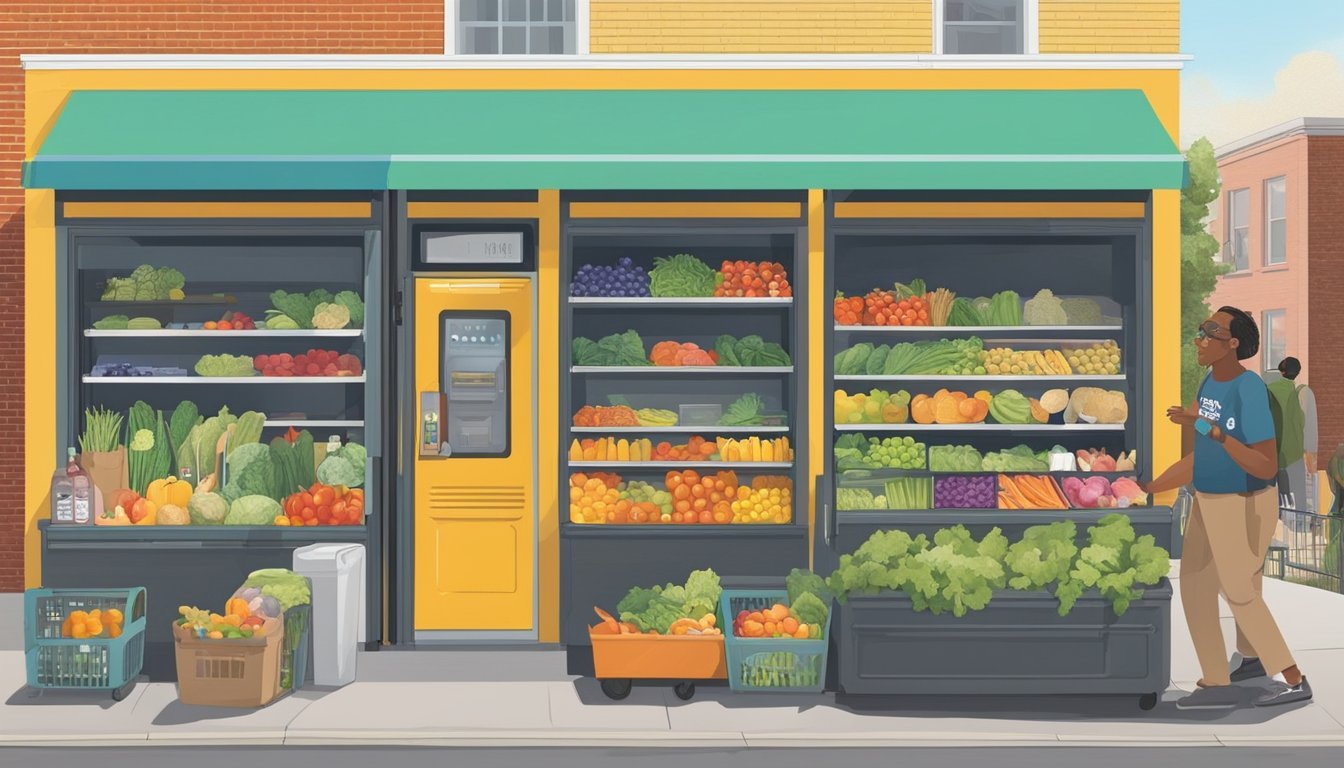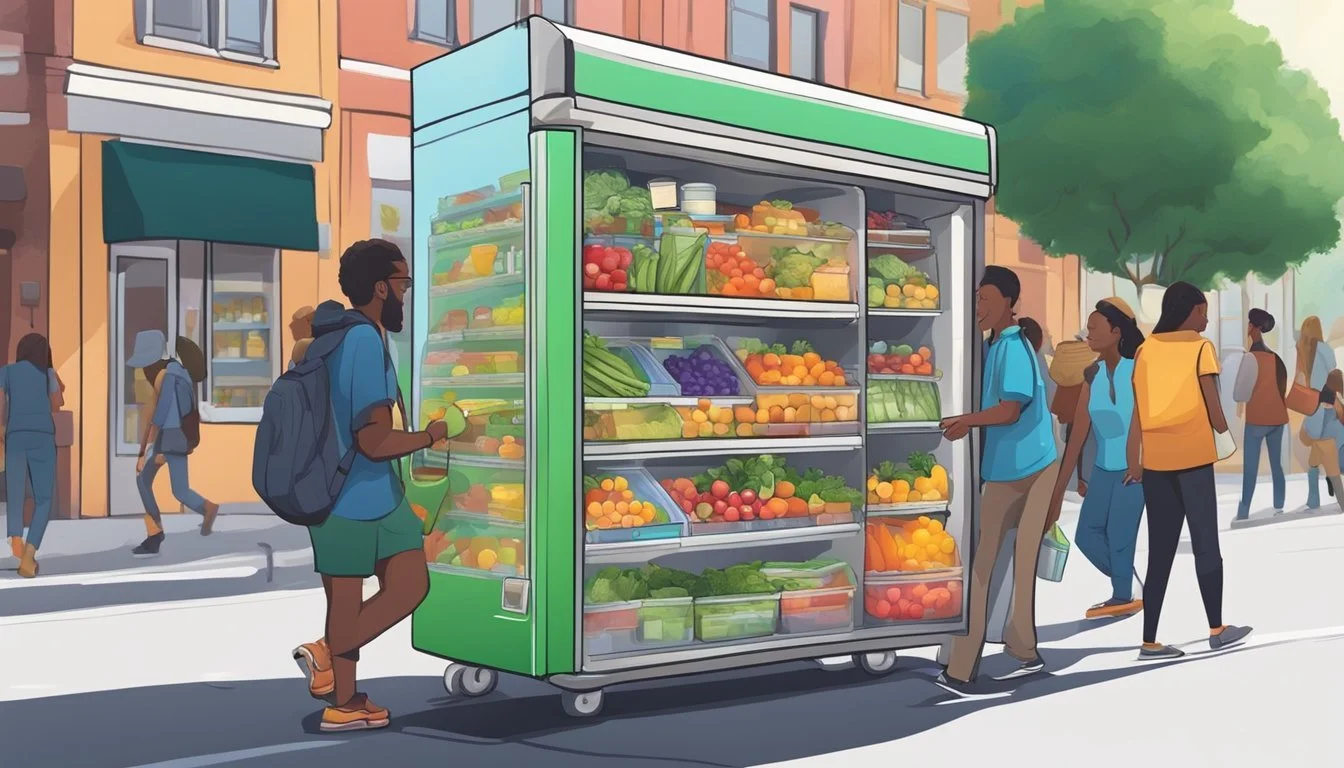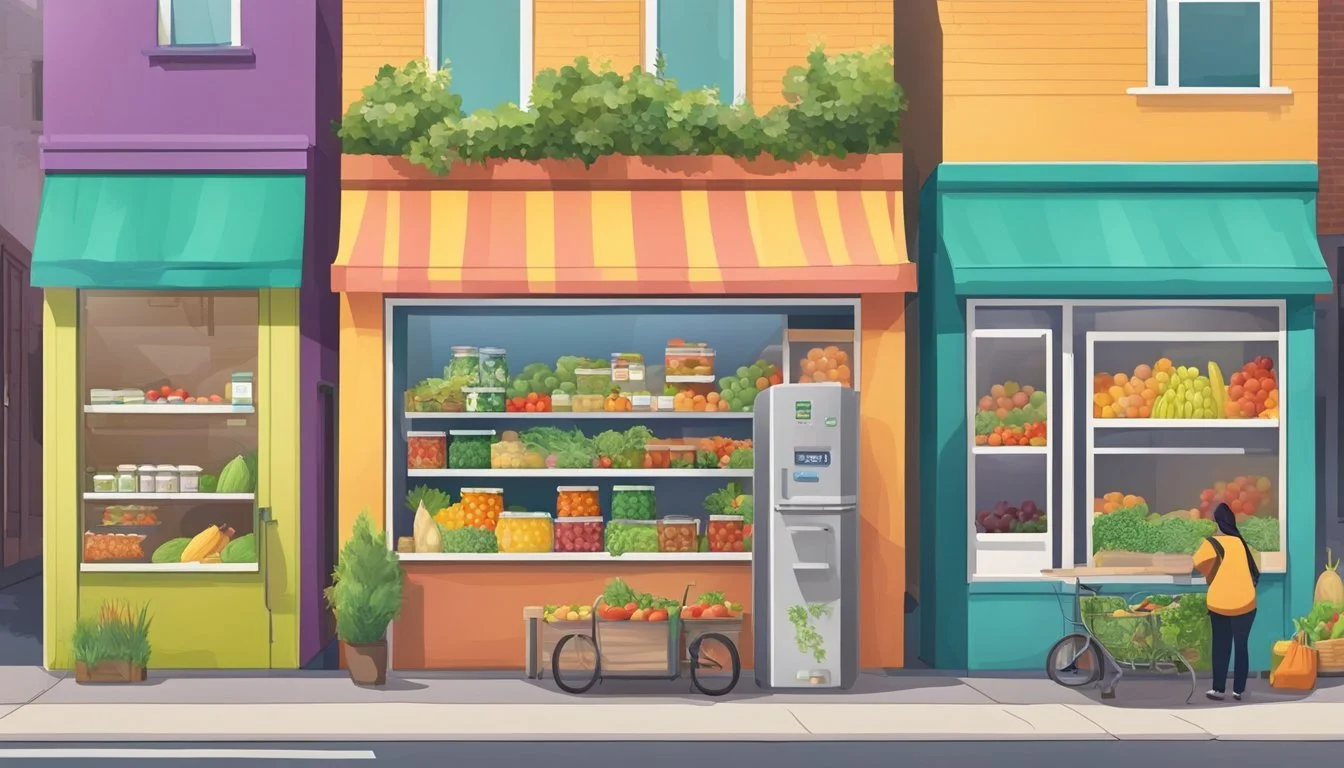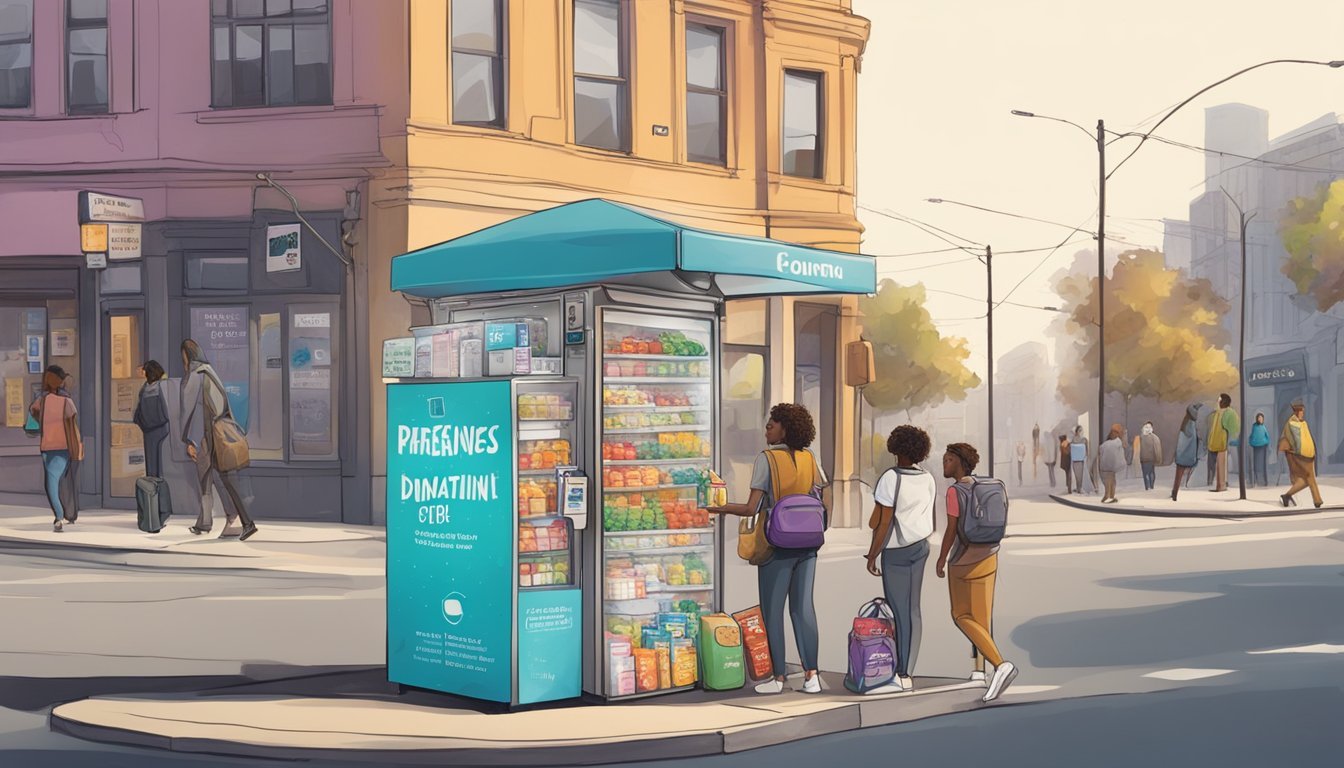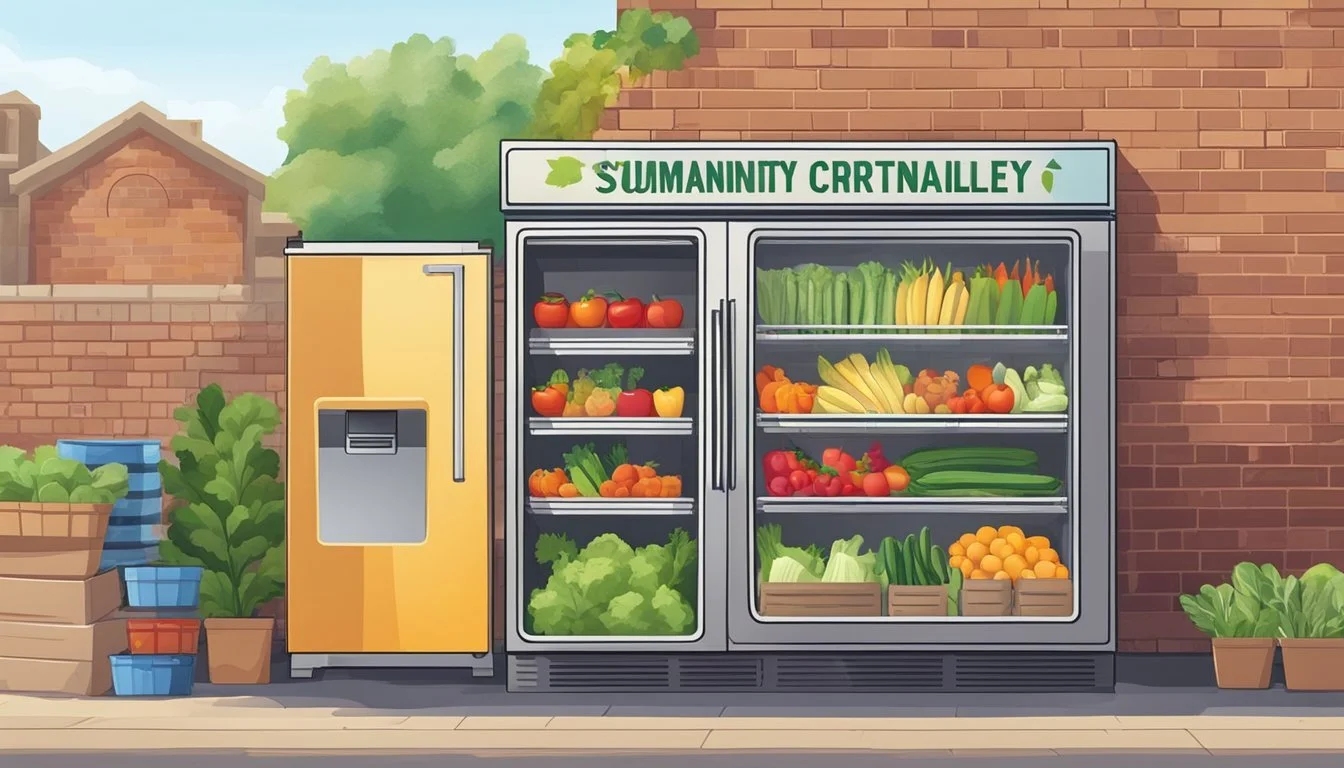Columbia, MO Community Fridge
Nourishing Neighborhoods, One Meal at a Time
In Columbia, Missouri, a progressive initiative is taking shape to address food insecurity and promote community solidarity. The community fridge movement, rooted in the simple concept of "take what you need, leave what you can," is gaining traction in the city. These fridges are public and accessible to all, offering a place where individuals can share surplus food and those in need can obtain food without any cost or barriers.
The introduction of the Columbia MO Community Fridge represents more than just a food assistance program; it's a testament to communal efforts and sustainability. This novel approach to combating hunger builds on the idea that community care can be woven into the fabric of urban living. It's a system that not only provides immediate relief in the form of free, accessible food but also fosters a deeper sense of communal responsibility and support.
Through this endeavor, Columbia is showcasing how a city can come together to ensure that all of its residents have access to basic necessities. The community fridge operates on trust and relies on the goodwill and participation of locals, ranging from individual community members to businesses and organizations. It's a clear indication of the city's commitment to creating inclusive solutions that cater to the well-being of its residents.
Community Fridge Concept
The inception of community fridges offers an innovative solution to food insecurity by providing accessible food resources, while also addressing the issue of food waste through a mutual aid system.
Defining Community Fridge
A community fridge is a publicly accessible refrigerator where individuals or businesses can share surplus food and where those in need can take what they require, free of charge. These fridges are often placed in public, accessible places, making them available to everyone in the community. The key features of community fridges are:
Accessibility: They are located in public spaces, accessible to all.
Community-driven: Both stocking and maintenance often rely on volunteers and donations.
Emphasis on fresh foods: Prioritizes the distribution of perishable items like fruits and vegetables.
History and Evolution
Community fridges originated as a grassroots response to global food waste and local food insecurity issues. Over time, the concept has evolved from singular, isolated fridges to networks of refrigerators supported by organizations and volunteer groups. They:
Began appearing in urban areas but are now found in various communities.
Were initially informal but have become more organized with clear guidelines on food safety and donation types.
Impact on Food Insecurity
Community fridges serve as a resource to alleviate food insecurity by providing immediate, no-cost access to food. Their impact includes:
Direct aid: They offer a direct line of support for individuals facing food scarcity.
Resources management: By redistributing excess food, they play a part in managing community resources more effectively.
Community engagement: Encourage a system of mutual aid where residents support one another.
By their very design, community fridges offer a simple, local solution to the complex global challenges of food insecurity and food waste.
Columbia's Community Fridge Network
The Community Fridge Network in Columbia, Missouri offers a creative solution to address food insecurity and reduce food waste. Through the collaboration of local organizations and farms, this initiative provides free access to food for those in need.
Current Locations
Community Center Fridge: Located at the local community center, accessible to all residents.
Church Fridge: Found within a church premises, serving the nearby communities.
Note: Locations are in accessible public spaces and operate on an honor system to serve community members.
Participating Organizations
Local Restaurants: Contribute surplus meals, reducing waste and providing nutritional options.
Supermarkets: Donate perishable items close to the sell-by date.
These organizations work in unison to keep the fridges stocked and operational, portraying a strong partnership in fighting hunger.
Urban Roots Farm Involvement
Urban Roots Farm, a local agricultural mainstay, plays a crucial role by providing freshly grown produce to the program. This involvement not only introduces fresh options into the community diet but also underscores the value of local farm produce in urban settings.
The partnership between the Community Fridge Network and Urban Roots Farm exemplifies the symbiotic relationship between urban community initiatives and local agriculture.
Donation Guidelines
When contributing to the Columbia, MO Community Fridge, donors should adhere to specific guidelines to ensure that the provided items are safe and beneficial for the community. These standards aim to maintain a hygienic, respectful, and equitable environment for all users.
Acceptable Food Items
The Community Fridge accepts a variety of food items that are both nutritious and in good condition. Donated items must fall within the following categories to ensure they meet the quality and safety standards:
Fresh Produce: Must be fresh and not past its prime.
Bread and Bakery Items: Should be within the best before date.
Dairy Products: Including milk and eggs, provided they are kept refrigerated and are not close to expiration.
Nonperishable Items: Such as rice, pasta, and cereal—unopened and in their original packaging.
Canned Goods: Ensure cans are not dented, rusted, or expired.
Bottled Water: Sealed and within the expiration date.
It's imperative that all donated food is unopened and in its original packaging, with clearly labeled expiration dates to avoid any health risks.
How to Donate Food
When donating to the Community Fridge, individuals should follow these steps to ensure a smooth donation process:
Check Expiration Dates: Before donating, verify that all food items are within their consumption date.
Package Appropriately: Place fresh produce in clear, clean packaging.
Segregate Items: Keep refrigerated items separate from nonperishables to prevent cross-contamination.
Labeling: If applicable, label homemade or homegrown food with the contents, date of production, and potential allergens.
Transport Safely: Transport refrigerated items in a cool bag to maintain the right temperature until they reach the fridge.
Donors are encouraged to drop off their contributions during designated donation hours to ensure the items can be properly managed and distributed.
Volunteer and Community Involvement
Community fridges in Columbia, MO, rely on the spirit of volunteerism and the collective effort of the community. They provide essential opportunities for residents to actively participate in addressing food insecurity.
Volunteering Opportunities
Volunteers play a crucial role in maintaining and operating community fridges. Opportunities for volunteers include:
Organizing food donations: Ensuring the fridge is well-stocked with fresh and nutritious foods.
Cleaning and maintenance: Regularly cleaning the fridge and its surroundings to maintain hygiene standards.
Outreach and education: Spreading awareness about the community fridge and teaching others about food waste and community sharing.
Community Benefits
The efforts of volunteers bring multiple benefits to the community, such as:
Reduced food insecurity: Access to a community fridge can be a lifeline for those who struggle to afford sufficient food.
Environmental impact: Minimizing food waste helps to reduce the environmental footprint.
Social cohesion: Volunteering cultivates a sense of unity and reinforces the social fabric of Columbia.
Supporting and Expanding the Initiative
Expanding the Columbia, MO Community Fridge initiative relies heavily on local engagement and external support mechanisms. From establishing a new fridge to ensuring sustainable operations, strategic steps in planning, funding, and partnerships are crucial components of success.
How to Start a Community Fridge
To start a community fridge in Columbia, MO, one should connect with city health departments for food safety guidelines and secure a location with high foot traffic. It's important to engage with the local community to raise awareness and support. Setting up a GoFundMe campaign can help cover initial costs such as purchasing the fridge and paying for electricity.
Check with local authorities: Consult with health departments to understand the regulations.
Choose a location: Find a visible and accessible spot for the fridge.
Launch a crowdfunding campaign: Platforms like GoFundMe can assist in raising funds for startup costs.
Funding and Grants
Funding can be acquired through a variety of means such as local business sponsorships, fundraisers, and grants. Organizations interested in starting a community fridge should research nonprofits that offer dedicated funds for such food security projects. Regular donations can greatly assist with day-to-day running costs.
Seek local sponsorships: Partner with businesses for financial or in-kind support.
Apply for grants: Identify and apply for grants tailored to community-led food security initiatives.
Accept donations: Encourage the community to donate food and funds to keep the fridge stocked.
Collaborations and Partnerships
Creating strategic partnerships amplifies the program's reach and efficacy. Collaborating with local restaurants, farmers' markets, and grocery stores can help in securing quality food donations. Nonprofit alliances may offer structural support and help with navigating legal considerations.
Build relationships with food providers: Local restaurants and stores can supply fresh meals and produce.
Form nonprofit alliances: Collaborate with organizations to gain operational expertise.
Engage with other community fridges: Share resources and knowledge to improve the community fridge network.
Health and Safety Considerations
Community fridges in Columbia, Missouri, operate with stringent health and safety protocols to ensure that the food provided meets safety standards and that the risks posed by COVID-19 are appropriately managed.
Maintaining Food Safety
To ensure the food shared is safe for consumption, the community fridge, often referred to as a freedge, should adhere closely to the State of Missouri Food Code, which reflects the FDA 2009 Model Food Code guidelines. These include:
Regularly monitoring temperatures within the refrigerator to guarantee that it remains at or below 40°F (4°C).
Sanitizing and cleaning the refrigerator and surrounding area frequently to prevent cross-contamination.
Encouraging donors to label food with clear preparation and expiry dates.
Prohibiting the donation of high-risk foods, such as those that require careful temperature control or homemade items that lack ingredient transparency.
Covid-19 Precautions
During the coronavirus pandemic, additional safety measures are crucial within community fridge initiatives:
Enforcing social distancing by placing markers or signs to space out visitors.
Providing hand sanitizers or handwashing stations nearby for users before and after handling food items.
Implementing a regular disinfection schedule for the fridge's handle and surfaces.
Limiting the number of individuals accessing the fridge at once to prevent crowding.
By following these specific protocols, community fridges like those in Columbia can continue to offer safe, accessible food-sharing services during the pandemic and beyond.
Promotion and Awareness
Promoting the Columbia, MO Community Fridge involves a strategic approach centered on increasing visibility and encouraging community participation. The promotion ensures the fridge is utilized to its full potential and that those in need are aware of its presence.
Social Media Outreach
The Columbia Community Fridge leverages Instagram and other platforms to reach a broader audience. They utilize consistent hashtags and share vibrant images featuring the fridge's contents and its impact. This approach not only raises awareness but also fosters a sense of community by sharing stories of support and gratitude.
Install Instagram live streams to showcase real-time contributions and pickups.
Create informative posts and stories with clear visuals of the fridge's location and available items.
Community Events
Hosting and participating in community events are pivotal for the promotion of the Columbia Community Fridge. These events serve as a nexus for residents to learn about the fridge, donate, and volunteer.
Organize ribbon cuttings with local officials to garner media attention and community support.
Facilitate regular gatherings that highlight the fridge's role in hunger alleviation and encourage local involvement.
Each event is strategically designed to inform the public, boost community morale, and maintain a steady flow of contributions to the fridge.
Community Fridge Design and Sustainability
Community fridges in Columbia, MO, embody practical innovation and eco-friendly practices. These aspects ensure that the refrigerators serve their purpose effectively while contributing to environmental conservation.
Innovative Design Solutions
The community fridges of Columbia, MO, arose from a design challenge meant to address food insecurity creatively. Part of the challenge involved a design competition organized by groups like Free Fridge SGF. Participants offered creative solutions on how the fridges should operate and integrate within the community space. The winning designs often featured the following characteristics:
Adaptability: The ability to fit within various urban settings while remaining accessible to all community members.
User-friendly: Designed with a simple interface so that people of all ages and abilities can use them without difficulty.
Sustainability Practices
When it comes to sustainability, the key is to minimize environmental impact while maximizing the fridge's lifespan and utility. Practices incorporated into the community fridges include:
Energy efficiency: Refrigerators are chosen based on their energy ratings, to reduce electricity usage and lower carbon footprints.
Collaborative maintenance: Maintenance responsibilities are distributed among community members, extending the life of the refrigerators and fostering a sense of ownership.
In summary, each refrigerator is a testament to how community-led interventions can leverage design for social good and sustainability.
Legal and Ethical Considerations
When operating the Columbia, MO Community Fridge, it is essential to adhere to legal protections provided to food donors and to establish clear ethical guidelines for contributions. This ensures the safety and reliability of the food distribution process.
Food Donation Protection Act
The Bill Emerson Good Samaritan Food Donation Act provides a federal layer of protection for donors against civil and criminal liability, should the product donated in good faith later cause harm to its recipient. In Missouri, donors must ensure that the food is safe for consumption at the time of donation. Food must not be adulterated or mislabeled, and it should meet all local and state food safety regulations.
Key Points:
Federal protection under the Bill Emerson Good Samaritan Food Donation Act.
Donors must verify that food is safe and not mislabeled.
Compliance with local and state regulations is mandatory.
Ethical Guidelines for Donations
Donors are encouraged to follow ethical guidelines to maintain the integrity of donations:
Quality: All food items should be of a quality that the donors themselves would consume.
Dignity: The donations should respect the dignity of recipients, providing nutritious options without discrimination.
Respect for Allergies and Dietary Restrictions: Clear labeling is important to aid recipients in selecting food that is safe and appropriate for their dietary needs.
Considerations include avoiding the donation of expired products, those close to expiration without reasonable consumption expectations, or items that require preparation or tools the recipients might not have.
Dynamics With Related Programs
The Columbia, MO Community Fridge operates in conjunction with broader food security networks and local initiatives. These relationships play a critical role in extending the reach of food assistance to those who need it.
SNAP and Feeding America
Supplemental Nutrition Assistance Program (SNAP), formerly known as food stamps, provides eligible individuals and families with funds to purchase groceries. The Columbia Community Fridge complements these efforts by offering immediate access to free food without the need for formal applications or qualification, bridging gaps that may exist for those awaiting SNAP benefits.
Feeding America is a nationwide network of more than 200 food banks that leads the fight against hunger. The community fridge can act as a touchpoint for the distribution of surplus food from Feeding America, preventing waste and directing resources where they are immediately beneficial.
Mutual Aid and Grassroots Movements
Mutual aid groups in Columbia emphasize community solidarity, where neighbors support each other without expecting anything in return. The community fridge embodies this principle by encouraging residents to leave what they can and take what they need.
A grassroots response to hunger can often be more adaptable to local needs than larger organizations. It's fostered by the collective effort of volunteers and community members donating time and resources, often inspired by a shared commitment to local wellbeing and sustainability.
Challenges and Solutions
The Columbia, MO Community Fridge faces issues of security and sustainability as it serves the local community. These challenges are met with proactive measures to ensure continuous support for those in need.
Addressing Vandalism and Theft
The occurrence of vandalism and theft poses a significant challenge. To combat this:
Security Cameras: Installation of cameras acts as a deterrent and helps identify perpetrators.
Community Vigilance: Encouraging local residents to keep an eye on the fridge can increase security.
Sustaining Operations Amid Challenges
Sustaining operations is vital for the continued success of the community fridge. The following strategies are employed:
Volunteer Support: A robust roster of volunteers ensures the fridge is well-maintained and stocked.
Donation Drives: Regularly organized drives keep supplies flowing and awareness high.
By implementing these strategies, Columbia's community fridge strives to address its key challenges head-on, maintaining a vital resource for those who depend on it.

